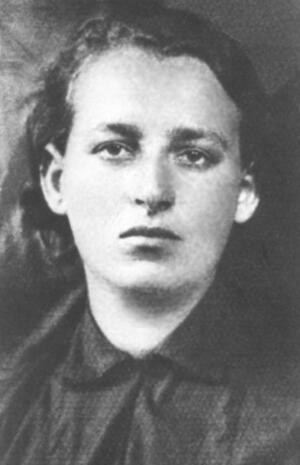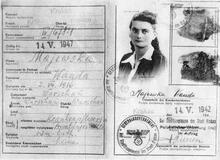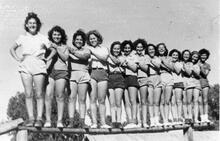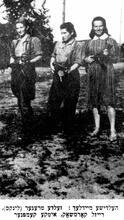Frumka Plotniczki
Frumka Plotniczki was born in Plotnica (in what is now Belarus) in 1914 to a family with deep roots in the Karliner hasidic community. She became involved in the local chapter of Freiheit at age seventeen and was involved in the Zionist He-Haluz movement. Starting out at a kibbutz at Bialystok as an ordinary member without an official position, she soon found herself in the forefront of the action, bringing others in her wake. Later, she was part of the central office of the movement, traveling from district to district and playing an active role in movement seminars and other gatherings. Whether in her family, the kibbutz training program or the movement, what set Plotniczki apart was her ability to combine penetrating, uncompromising analysis with a loving heart and maternal compassion.
Early Life
Frumka Plotniczki was born in 1914 in Plotnica (Plotnitsa, near Pinsk, in what is today Belarus) to a family with deep roots in the Karliner A member of the hasidic movement, founded in the first half of the 18th century by Israel ben Eliezer Ba'al Shem Tov.Hasidic community. When she was six, her family moved to Pinsk. Financial difficulties prevented Frumka and her younger sister Hantze Plotniczki from attending school and instead they studied with their older sister Zlatka, who attended a Polish gymnasium.
Zlatka emigrated to Argentina, a brother, Eliyahu, emigrated to Palestine in 1932, and her younger brother Hershel, who was active in the Jewish underground, died in the forests of Volhynia.
Activism
Plotniczki, who became active in the local chapter of Freiheit at the age of seventeen, also represented the movement on the He-Haluz leadership committee in Pinsk. In 1935 Plotniczki participated in the hakhsharah (training) program at A voluntary collective community, mainly agricultural, in which there is no private wealth and which is responsible for all the needs of its members and their families.Kibbutz Tel Hai in Bialystok. From this point on, her life story is essentially the story of the movement: Starting out at the kibbutz at Bialystok as an ordinary member without an official position, she soon found herself in the forefront of the action, bringing others in her wake. Later, she was part of the central office of the movement, traveling from district to district and playing an active role in movement seminars and other gatherings. Whether in her family, the kibbutz training program, or the movement, what set Plotniczki apart was her ability to combine penetrating, uncompromising analysis with a loving heart and maternal compassion.
Actively involved in the unification of Freiheit and He-Haluz ha-Za’ir in September 1938, Plotniczki joined the leadership of the united movement. Her immersion in the movement was total.
In the summer of 1939 activities were at their height, with seminars, summer sessions and anticipation of visits from Lit. "ascent." A "calling up" to the Torah during its reading in the synagogue.aliyah emissaries who were, however, no longer arriving. The circle of activists contracted, leaving the major responsibility on Plotniczki’s shoulders. Despite her longing for The Land of IsraelErez Israel, she promised to remain until the end of the summer. The movement’s central committee in Łódź then decided to postpone her aliyah until autumn—a verdict that Plotniczki dutifully accepted.
When war broke out and the leadership of the youth movements relocated eastward, Plotniczki was the first to return to Warsaw to assist her comrades and seek a link with Erez Israel. During the first half of 1940 she maintained contact between the Warsaw headquarters and the branches in Bedzin, Czestochowa, Łódź, Radomsko, Lublin and others, meanwhile recruiting friends to carry on the movement’s activities. Between January and May 1942 she visited Vilna, Kovel and Bialystok where she led a Dror Seminar.
Diplomatic
Plotniczki was the chief emissary of He-Haluz’s central office in Warsaw and the first to bring word of the scope of the extermination of Polish Jewry in the eastern districts. Her eyewitness account had a crucial effect on the redirecting of activities in Warsaw. In spite of her travels, Plotniczki was fully involved in activities at the Warsaw office. At a critical meeting on July 28, 1942, it was decided to establish the Jewish Fighting Organization (Z.O.B.), with Plotniczki as a member of the mission to the Aryan side, assigned to seek contact with the Polish underground and obtain weapons.
Plotniczki’s actions during the difficult days in Warsaw, and in the Ghetto in particular, stretched beyond the circle of the movement; the maternal concern that had characterized her from her earliest days was now a source of help and support for numerous Jewish refugees. As part of the leadership in Warsaw, Plotniczki was the first to travel to isolated towns and serve as their contact with the movement. She journeyed to the most far-flung locales and, against all logic, was the movement’s “wandering emissary” throughout the length and breadth of Poland. Her features were not those of the typical Aryan; her nose was Jewish and her Polish was halting.
Sent to Bedzin on behalf of the movement in December 1942, following the major Aktion in Warsaw, Plotniczki was the driving force in the struggle to keep the organization alive and lay the groundwork for resistance operations. The weeks following the suppression of the Warsaw Ghetto uprising were particularly difficult for Plotniczki; her younger sister Hantze was among the fallen fighters.
Faced with a dilemma between continuing the preparations for the uprising in Bedzin and obtaining passports in the event it became possible to leave Poland, Plotniczki decided not to abandon the plans for resistance but to see to it that every member of the movement had a passport should the need arise. Despite the pressure on her to relocate to a neutral country as one of the last surviving eyewitnesses, she rejected the idea and chose to remain with her comrades in Bedzin.
Through an emissary who arrived a few days before the liquidation, Plotniczki managed to smuggle out a letter containing her testimony along with a last will and testament to her friends in Erez Israel—the climax of a correspondence that had lasted throughout the war.
On August 1, 1943, the liquidation of the Bedzin ghetto began. Plotniczki fell together with her comrades-in-arms in the “laundry bunker” of Kibbutz Dror on August 3.
Hantze and Frumka, Tel Aviv: 1945.
Neustadt, Melekh. The Destruction and Resistance of the Jews of Warsaw. Tel Aviv: 1947.
Perelis, Rivkah. “Pioneer Youth Movements in Occupied Poland.” PhD diss., Kibbutz Lohamei ha-Getta’ot, 1987.
Shimshi, Naomi. “Frumka Plotniczki.” In Guf Shelishi Yahid I, edited by Avihu Ronen and Yehoyakim Kokhavi. Tel Aviv: Kibbutz Lohamei ha-Getta’ot, 1994.
Zuckerman, Yitzhak. Those Seven Years: 1939–1946. Tel Aviv: Kibbutz Lohamei ha-Getta’ot, 1990.








